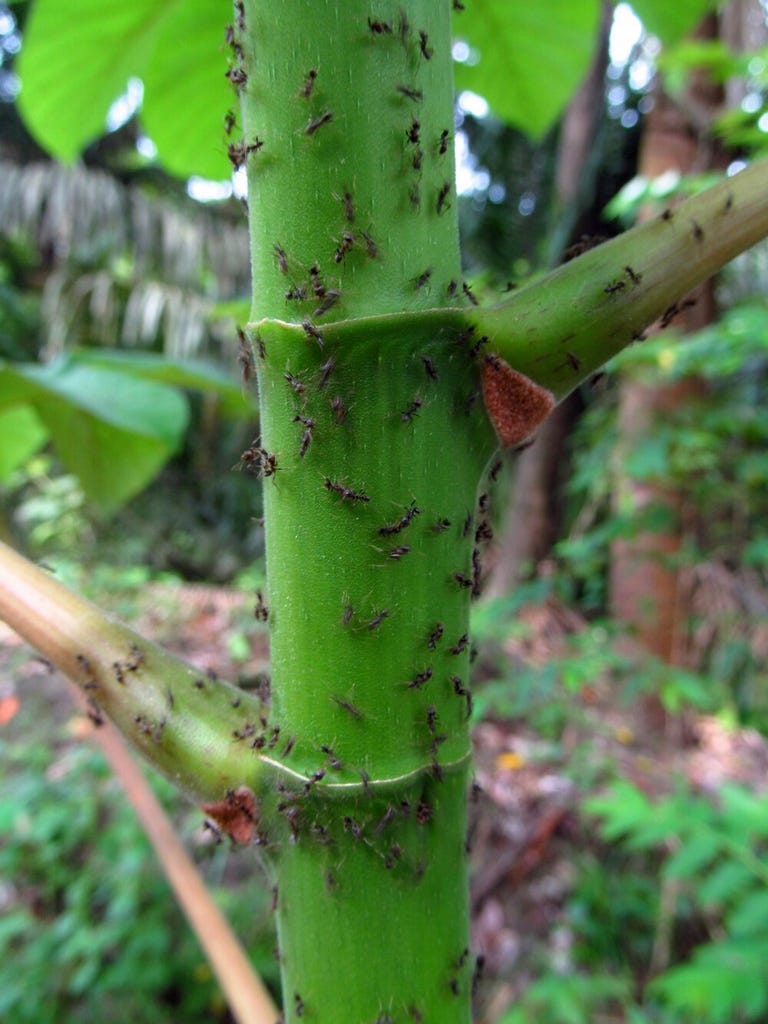Ant Hotels
Your room is ready...
There are a lot of intimate, evolved, symbiotic relationships between insects and plants in the temperate zones, but in the tropics these go absolutely nuts, in a manner of speaking. Intricacy pretty much describes the relationships among about 100 species of tropical American trees in the genus Cecropia, and about a dozen genera of ants that inhabit them, in some cases living nowhere else but on these trees. In the exclusively arboreal ant genus Azteca alone, there are probably a dozen or more that are found only on Cecropia trees, and then sometimes on particular Cecropia species and not others. The ants and trees form a shifting tapestry of associations, varying by geography, climate, altitude, and forest successional stage. Many Cecropia species are fast-growing trees that colonize areas where humans have whacked the forest, and since tropical humans do so much forest-whacking, there are lots of Cecropia of all ages and species around, and therefore lots of opportunities for their ants.


A Cecropia tree consists of a stack of hollow sections that form at the growing tip and lengthen to make the tree grow in height. Being hollow is a cheap way of growing a lot of stem fast, and without a lot of material, but being hollow also creates an opportunity for creatures that like to inhabit cavities. Starting with newly mated queens of several species of Azteca, the ants chew their way through a weak spot in each section, and live inside, so in essence, Cecropia is an ant apartment high-rise, and the newly mated ant queens are hoping to secure a lifetime lease as they seal themselves in, and without feeding, rear their first little colony of workers from body reserves. Most fail, and the workers of those that succeed vie for possession of the tree.

The surviving colony grows with the tree, chewing its way into one apartment after another as the colony grows. Remarkably, like a fine hotel, the tree also provides them with food, for each section bears not only a single, large palmate leaf, but a patch of hairs that produces nutritious blobs that the ants harvest to eat. For the tree to go to this trouble suggests that the ants are doing something worthwhile for the tree.

Biologists argue whether the Azteca-Cecropia association is a mutualism, that is, is beneficial to both ant and tree. The top-rated suggestion is that the ants protect the tree from various dangers and damages. You won't find this hard to believe if you ever find yourself climbing a slippery hill in Costa Rica, and puffing and sweating, grab a Cecropia tree for support during a puff-stop. A moment or two later, you will find yourself swatting and rubbing thousands of ants that have rained down upon you, get tangled in your hair, bite your eyelids, run up your nose, into your armpits, under your shirt, up your pants and into your ears. Although Azteca don't sting, they bite quite proficiently and the sensation of a thousand biting at once certainly gets your attention.

The experience would make you think twice before leaning on another Cecropia, so this is a sort of sloppy evidence that the ants protect the tree from creatures that would do it harm (though probably not you, personally). Cecropia trees that lack an ant colony are much more likely to be eaten by other creatures, especially herbivorous insects. In return, the plant provides everything that Azteca needs, and I mean everything, starting with the beginning of the ant life cycle until both host and colony die of old age.

It seems reasonable to regard the Cecropia and its ants as “one unit of life.” Without the Cecropia, several species of ants have nowhere to go, for Cecropia is their whole world. Without the ants, Cecropia is victim to many herbivores, and individual Cecropia trees that rent to ant tenants do much better than those that don't. Ant-apartments are a good business model and a profitable one. A lot of Cecropia and ant species seem to agree.

Mutualism is addictive….and a charming way to live….
Yes co-evolution and mutualism are thought provoking subjects. I can’t read enough about them.